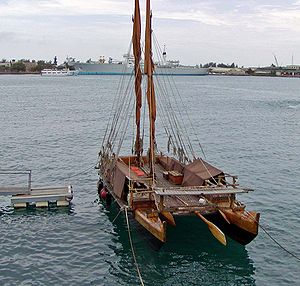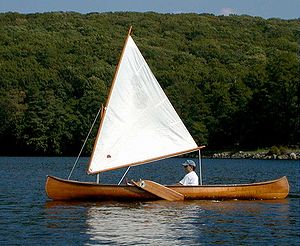
Canoe sailing
Encyclopedia



Polynesia
Polynesia is a subregion of Oceania, made up of over 1,000 islands scattered over the central and southern Pacific Ocean. The indigenous people who inhabit the islands of Polynesia are termed Polynesians and they share many similar traits including language, culture and beliefs...
n outrigger
Outrigger canoe
The outrigger canoe is a type of canoe featuring one or more lateral support floats known as outriggers, which are fastened to one or both sides of the main hull...
or Western
Western culture
Western culture, sometimes equated with Western civilization or European civilization, refers to cultures of European origin and is used very broadly to refer to a heritage of social norms, ethical values, traditional customs, religious beliefs, political systems, and specific artifacts and...
canoe
Canoe
A canoe or Canadian canoe is a small narrow boat, typically human-powered, though it may also be powered by sails or small electric or gas motors. Canoes are usually pointed at both bow and stern and are normally open on top, but can be decked over A canoe (North American English) or Canadian...
with sail
Sail
A sail is any type of surface intended to move a vessel, vehicle or rotor by being placed in a wind—in essence a propulsion wing. Sails are used in sailing.-History of sails:...
s.
See also log canoe
Log canoe
The log canoe is a type of sailboat developed in the Chesapeake Bay region. Based on the dugout, it was the principal traditional fishing boat of the bay until superseded by the bugeye and the skipjack. However, it is most famous as a racing sailboat, and races continue to be held.The history of...
, a type of sailboat used in the Chesapeake Bay
Chesapeake Bay
The Chesapeake Bay is the largest estuary in the United States. It lies off the Atlantic Ocean, surrounded by Maryland and Virginia. The Chesapeake Bay's drainage basin covers in the District of Columbia and parts of six states: New York, Pennsylvania, Delaware, Maryland, Virginia, and West...
region.
Polynesian sailing canoes
The first sailing canoes emerged in ancient PolynesiaPolynesia
Polynesia is a subregion of Oceania, made up of over 1,000 islands scattered over the central and southern Pacific Ocean. The indigenous people who inhabit the islands of Polynesia are termed Polynesians and they share many similar traits including language, culture and beliefs...
over 1,000 years ago.
The canoes were built from island materials such as plaited leaf sails, island woods, organic webbing. The manned paddle
Paddle
A paddle is a tool used for pushing against liquids, either as a form of propulsion in a boat or as an implement for mixing.-Materials and designs:...
d sailing canoes explored the vast Pacific Ocean
Pacific Ocean
The Pacific Ocean is the largest of the Earth's oceanic divisions. It extends from the Arctic in the north to the Southern Ocean in the south, bounded by Asia and Australia in the west, and the Americas in the east.At 165.2 million square kilometres in area, this largest division of the World...
. The Polynesian voyaging canoes are to ancient Polynesian culture as the invention of the wheel in Asia and Europe. Today there is a revival of canoe sailing in Polynesia and racing is very much alive in the Hawaiian Islands
Hawaiian Islands
The Hawaiian Islands are an archipelago of eight major islands, several atolls, numerous smaller islets, and undersea seamounts in the North Pacific Ocean, extending some 1,500 miles from the island of Hawaii in the south to northernmost Kure Atoll...
in particular. Hawaiian sailing canoes have evolved: Wood has been replaced by glass-reinforced
Glass-reinforced plastic
Fiberglass , is a fiber reinforced polymer made of a plastic matrix reinforced by fine fibers of glass. It is also known as GFK ....
and carbon fiber-reinforced polymer
Carbon fiber-reinforced polymer
Carbon-fiber-reinforced polymer or carbon-fiber-reinforced plastic , is a very strong and light fiber-reinforced polymer which contains carbon fibers. The polymer is most often epoxy, but other polymers, such as polyester, vinyl ester or nylon, are sometimes used...
, sails are now made from Dacron and Kevlar
Kevlar
Kevlar is the registered trademark for a para-aramid synthetic fiber, related to other aramids such as Nomex and Technora. Developed at DuPont in 1965, this high strength material was first commercially used in the early 1970s as a replacement for steel in racing tires...
.
The Hōkūlea
Hokulea
Hōkūlea is a performance-accurate full-scale replica of a waa kaulua, a Polynesian double-hulled voyaging canoe. Launched on 8 March 1975 by the Polynesian Voyaging Society, she is best known for her 1976 Hawaii to Tahiti voyage performed with Polynesian navigation techniques, without modern...
is an example of a replica of a Polynesian voyaging canoe. It has made many voyages across the Pacific.
North American sailing canoes
Canoes have been used for sailing since at least the 1860s. There are several racingCanoe racing
This article discusses canoe sprint and canoe marathon, competitive forms of canoeing and kayaking on more or less flat water. Both sports are governed by the International Canoe Federation ....
classes of sailing canoes: Cruising Class or 4 Meter, C Class or 5 Meter, International Decked Sailing Canoe
International Canoe
The International Canoe, or more properly the International Ten Square Meter Sailing Canoe, often abbreviated to IC is a powerful and extremely fast single handed sailing canoe whose rules are governed by the International Canoe Federation....
, and the American Canoe Association Class.
John MacGregor
John MacGregor (sportsman)
John MacGregor , nicknamed Rob Roy after a renowned relative, was a Scottish explorer, travel writer and philanthropist. He is generally credited with the development of the first sailing canoes and with popularising canoeing as a middle class sport in Europe and the United States...
of Scotland
Scotland
Scotland is a country that is part of the United Kingdom. Occupying the northern third of the island of Great Britain, it shares a border with England to the south and is bounded by the North Sea to the east, the Atlantic Ocean to the north and west, and the North Channel and Irish Sea to the...
is generally believed to have developed the first sailing canoes. During the 1860s, he had at least seven boats built that he called Rob Roys and sailed and paddled them in Europe
Europe
Europe is, by convention, one of the world's seven continents. Comprising the westernmost peninsula of Eurasia, Europe is generally 'divided' from Asia to its east by the watershed divides of the Ural and Caucasus Mountains, the Ural River, the Caspian and Black Seas, and the waterways connecting...
, the Baltic
Baltic Sea
The Baltic Sea is a brackish mediterranean sea located in Northern Europe, from 53°N to 66°N latitude and from 20°E to 26°E longitude. It is bounded by the Scandinavian Peninsula, the mainland of Europe, and the Danish islands. It drains into the Kattegat by way of the Øresund, the Great Belt and...
and the Middle East
Middle East
The Middle East is a region that encompasses Western Asia and Northern Africa. It is often used as a synonym for Near East, in opposition to Far East...
. He also wrote a book which popularized the design and the concept: "in walking you are bounded by every sea and river, and in a common sailing-boat you are bounded by every shallow and shore; whereas, ...a canoe [can] be paddled or sailed, or hauled, or carried over land or water" (1000 Miles in the Rob Roy Canoe).
MacGregor founded the British Royal Canoe Club
Royal Canoe Club
The Royal Canoe Club , founded in 1866, is the oldest canoe club in the world and received royal patronage in the 19th century. The clubhouse is based at Trowlock Island on the River Thames in Teddington near central London. The club promotes canoeing and kayaking, focusing on flatwater, sprint and...
(RCC) in 1866.
The New York Canoe Club followed about six years later.
The American Canoe Association
American Canoe Association
The American Canoe Association is the oldest and largest paddle sports organization in the United States, promoting canoeing, kayaking, and rafting. The ACA sponsors more than seven hundred events each year, along with safety education, instructor certification, waterway conservation and public...
(ACA) was founded in 1880. In 1883, ACA Secretary Charles Neide and retired sea captain “Barnacle” Kendall paddled and sailed over three thousand miles from Lake George, New York
Lake George (town), New York
Lake George is a town in Warren County, New York, USA. The population was 3,578 at the 2000 census. The town is named after the lake, Lake George. Within the town is a village also named Lake George. The town is part of the Glens Falls Metropolitan Statistical Area.- History :The lake was...
to Pensacola, Florida
Pensacola, Florida
Pensacola is the westernmost city in the Florida Panhandle and the county seat of Escambia County, Florida, United States of America. As of the 2000 census, the city had a total population of 56,255 and as of 2009, the estimated population was 53,752...
.
In 1886 the ACA and the RCC held the first international canoe sailing regatta
Regatta
A regatta is a series of boat races. The term typically describes racing events of rowed or sailed water craft, although some powerboat race series are also called regattas...
.
In 1991 American Howard Rice
Howard Rice
Howard Rice sailed and paddled a sailing canoe solo around Cape Horn, Chile considered by many sailors to be the Mount Everest of sailing challenges...
sailed and paddled a sailing canoe solo around Cape Horn
Cape Horn
Cape Horn is the southernmost headland of the Tierra del Fuego archipelago of southern Chile, and is located on the small Hornos Island...
, Chile
Chile
Chile ,officially the Republic of Chile , is a country in South America occupying a long, narrow coastal strip between the Andes mountains to the east and the Pacific Ocean to the west. It borders Peru to the north, Bolivia to the northeast, Argentina to the east, and the Drake Passage in the far...
considered historically to be the Mount Everest
Mount Everest
Mount Everest is the world's highest mountain, with a peak at above sea level. It is located in the Mahalangur section of the Himalayas. The international boundary runs across the precise summit point...
of sailing challenges. He was awarded a Certificate of Merit by the Chilean Navy
Chilean Navy
-Independence Wars of Chile and Peru :The Chilean Navy dates back to 1817. A year before, following the Battle of Chacabuco, General Bernardo O'Higgins prophetically declared "this victory and another hundred shall be of no significance if we do not gain control of the sea".This led to the...
and inducted into the Cape Horners Society.

